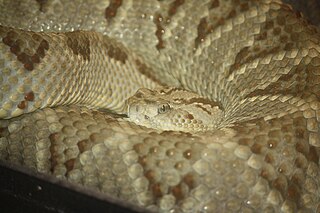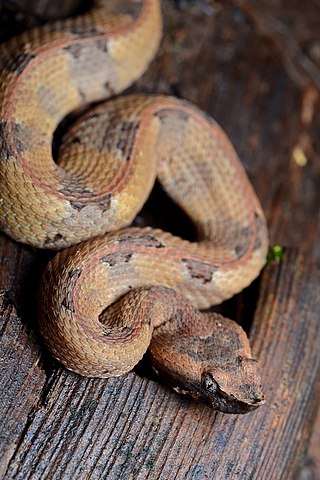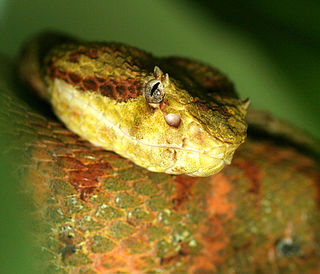
Metlapilcoatlus is a genus of venomous pit vipers endemic to Mexico and Central America. Six species are currently recognized. The common names suggest they are able to leap at an attacker, but this is likely exaggerated. Common names for the species include jumping pitvipers and jumping vipers. The genus name comes from the Nahuatl name metlapilcohuatl, which means of the oblong grindstone held in the hand when grinding corn - alluding to the snakes short stocky body.

Bothrops alternatus is a highly venomous pit viper species found in South America. Within its range, it is an important cause of snakebite. The specific name, alternatus, which is Latin for "alternating", is apparently a reference to the staggered markings along the body. No subspecies are currently recognized.

Bothriechis schlegelii, known commonly as the eyelash viper, is a species of venomous pit viper in the family Viperidae. The species is native to Central and South America. Small and arboreal, this species is characterized by a wide array of color variations, as well as the superciliary scales above the eyes. It is the most common of the green palm-pitvipers, and is often present in zoological exhibits. The specific name schlegelii honors Hermann Schlegel, who was a German ornithologist and herpetologist. For other common names see below. No subspecies are currently recognized as being valid.

Terciopelo is a highly venomous species of pit viper found at low to moderate elevations in northeast Mexico and Central America, and into South America where it is known from elevations up to 2600 meters in the Colombian and Ecuadorian Andes, as well as into Venezuela. With a mass of up to 6 kilograms (13 lb) and a maximal length of 2.5 metres (8.2 ft), the terciopelo is among the largest pit vipers. It is light to dark brown in color, often with yellow zig-zag-shaped lines on each side of the body. Dubbed "the ultimate pit-viper" for its large size, fangs and venom yield, it has a fearsome reputation, responsible for the most snakebites within its range because of its defensive temperament and proximity to human residence. However, like other venomous snakes, it avoids confrontation with humans whenever possible. No subspecies are currently recognized.

Bothriechis is a genus of venomous pit vipers, commonly called palm vipers or palm-pitvipers found predominantly in Mexico and Central America, although the most common species, B. schlegelii, ranges as far south as Colombia and Peru. All members are relatively slender and arboreal. The name Bothriechis is derived from the Greek words bothros and echis that mean "pit" and "viper" respectively. Ten species and no subspecies are currently generally recognized.

Porthidium is a genus of venomous pitvipers found in Mexico and southward to northern South America. The name is derived from the Greek word portheo and the suffix -idus, which mean "destroy" and "having the nature of", apparently a reference to the venom. As of August 2016 nine species are recognized as being valid. The snakes of the genus Hypnale in southern India and Sri Lanka look quite similar to those of this genus, possibly an example of convergent evolution.

Crotalus simus is a venomous pit viper species found in Mexico and Central America. The specific epithet is Latin for "flat-nosed", likely because its head is blunt compared with lanceheads (Bothrops). Three subspecies are recognized, including the nominate subspecies described here.

Porthidium hespere is a venomous pitviper species found in western Mexico. No subspecies are currently recognized.

Porthidium nasutum is a venomous pitviper species found in southern Mexico, Central America and northern South America. No subspecies are currently recognized.

Bothrops taeniatus, the speckled forest-pitviper, is a species of pit viper found in the equatorial forests of South America endemic to Colombia, Ecuador, Peru, And Brazil. The specific name, taenia, is derived from the Greek word, tainia, meaning ribbon bandage or stripe, in reference to the slender body. Two subspecies are currently recognized, including the nominate subspecies described here.

Bothrops bilineatus, also known as the two-striped forest-pitviper, parrotsnake, Amazonian palm viper, or green jararaca, is a highly venomous pit viper species found in the Amazon region of South America. Two subspecies are currently recognized, including the nominate subspecies described here. A pale green arboreal species that may reach 1 m (3.3 ft) in length, it is an important cause of snakebite throughout the entire Amazon region.

Metlapilcoatlus mexicanus is a venomous pitviper species endemic to Mexico and Central America.
Porthidium volcanicum, the Ujarran hognosed pitviper, is a venomous pitviper species endemic to Costa Rica. No subspecies are currently recognized.
Bothrops medusa is a venomous pitviper species endemic to Venezuela. No subspecies are currently recognized.

Bothrops oligolepis is a venomous pitviper species found in Peru and Bolivia. The specific name is derived from the Greek words oligo and lepis, meaning "few scales"; probably an allusion to the lower numbers of dorsal and ventral scales that it has compared to B. bilineatus. No subspecies are currently recognized.
Bothrops pulcher is a venomous pitviper species found in South America. The specific name is Latin, meaning "beautiful", in reference to the color pattern. No subspecies are currently recognized.

Bothrops punctatus is a venomous pitviper species found in Ecuador, Mostly in the Chocó Department in Western Colombia and Panama. No subspecies are currently recognized.

Bothrops brazili is a venomous pitviper species endemic to South America. There are no subspecies that are recognized as being valid.
Bothrocophias campbelli, commonly known as Campbell's toadheaded viper, the Ecuadorian toadheaded pitviper, and víbora boca de sapo in Spanish, is a species of venomous pitviper in the family Viperidae. The species is endemic to South America. No subspecies are currently recognized.

Bothriechis supraciliaris, commonly known as the blotched palm-pit viper and blotched palm-pitviper, is a species of venomous snake in the subfamily Crotalinae of the family Viperidae. The species is endemic to southern Pacific parts of Talamanca Mountain Range in Costa Rica and western Panama. No subspecies are recognized.















